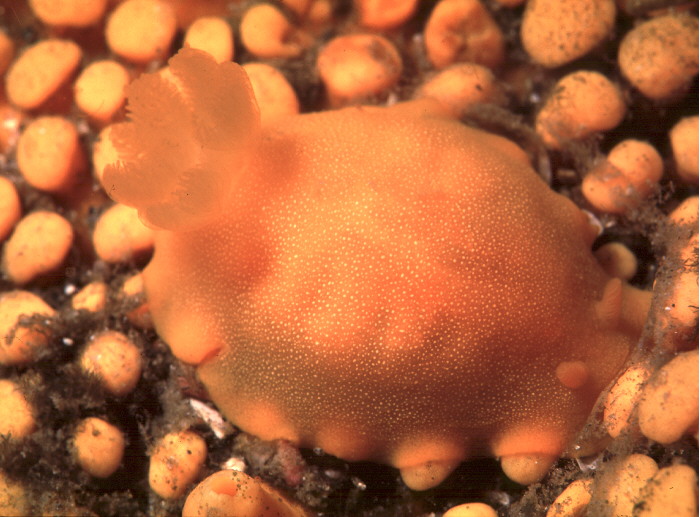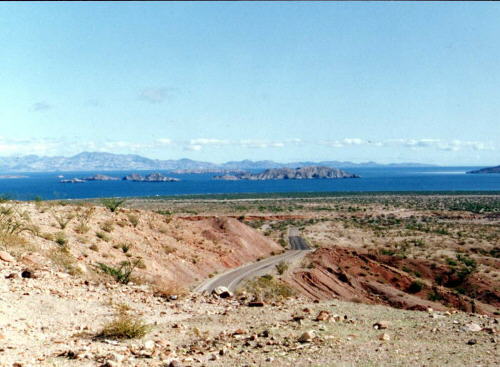 |
Doriopsilla gemela
Photo taken by Webmaster at Bahia de Los Angeles, Baja California, March 2000
Doriopsilla gemela Gosliner, Schaefer & Millen, 1999
The first time a photo of this species was published was in my Pacific Coast Nudibranchs as Dendrodoris sp. 1 (species #130). At that time it was known from a few specimens collected by Jim Lance in the San Diego area and several I had collected in San Luis Obispo, California. Most of the local Branchers referred to the species as the "yellow gilled" porostome, because the only external difference between this species and Doriopsilla albopunctata and what was until recently referred to as Dendrodoris fulva, was that its gills were yellow rather than white. The team of Gosliner, Schaefer and Millen, have now described the species, giving it the name "gemela", Spanish for twin, due to the close similarity with the other species.
This species is found primarily intertidally, and has one other distinctive feature, in that the egg mass is a coil that lies flat on the substrate, rather than on edge, as in D. albopunctata.
It has been documented to 40 mm in length, with a geographical range of: Gulf of California, from Bahia de Los Angeles, and along the Pacific coast of North America from Bahia Tortugas, Baja California Sur to Elkhorn Slough, Monterey County, California.
A most important contribution of Gosliner et. al (1999) is the clarification of the taxonomic validity of Dendrodoris fulva (MacFarland, 1905). Careful comparison of the internal anatomy of D. fulvaand Doriopsilla albopunctatus, showed the two to be identical, leaving D. albopunctata as the older and therefore name of preference.
After years of questions from 100's of divers and Branchers, I personally,
am elated that this nomenclatural dilemma has been solved.
Danville, Calif
Apr. 2000
Citation
Gosliner, Terrence M., Maria C. Schaefer & Sandra V. Millen. 1999. A new
species of Doriopsilla (Nudibranchia: Dendrodorididae) from the Pacific
coast of North America, including a comparison with Doriopsilla albopunctata
(Cooper, 1863). The Veliger 42(3): 201-210.
Photo courtesy of Dr. Wes Farmer

| This is the panoramic view that greets weary travelers on a clear day at Bahia de Los Angeles on the high ground before beginning the descent to this quaint fishing town. Depending on road conditions and traffic one can make it straight through from San Diego in 9-10 hours. The big island (Guardia) dwarfs the smaller island Isla de la Ventana in the immediate foreground. The tip of Cabeza de Caballo can be seen to the right Alan Grant and myself joined Hans Bertsch, Angel Valdes and Patrick McDonough in March for a few days of diving and branching. We were blessed with good weather which isn't always the case in this area. The water was still pretty cold but a good time was had by all. In particular, a specimen of what was thought to be Hypselodoris californiensis was found on the last dive, which upon closer examination turned out to be Hypselodoris ghiselini. Well, alas the search must go on! The last time I personally saw H. californiensis was almost 15 years ago on a channel islands dive. Has anyone else seen it as of late???? |
This area was the scene of a major tragedy shortly after we left BLA to return stateside A research party lead by Dr. Gary Polis, a leading authority on spiders and scorpions, was returning from a field trip to Isla de la Cabeza de Caballo when high winds capsized their boat. Five scientists, including Dr. Polis perished in the accident!
Taxonomic information courtesy of Dave Behrens

David W. Behrens
Author:
Pacific Coast Nudibranchs
Send Dave mail at seachalleng@earthlink.net
|
